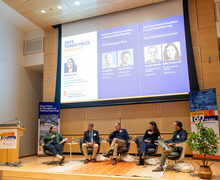‘The Big Picture’ author Ben Fritz gives his thoughts on the future of film
Katie Czerwinski | Digital Design Editor
While on spring break, I was wandering through Barnes & Noble and saw this book called “The Big Picture: The Fight for the Future of Movies.” It looked right up my alley, as it chronicled the recent ups and downs of the film industry through the lens of the Sony Pictures hack. I snatched it up and essentially read it in one sitting. It’s a must-read for anyone who loves film or is interested in how entertainment is created.
Below is an interview with the book’s author and reporter for The Wall Street Journal Ben Fritz, who gave me some great perspective on his writing process and the film industry, via email.
Erik Benjamin: Where did you get the idea to write this book?
Ben Fritz: It came out of the Sony hack, which I covered extensively for the Journal. I started speaking with my book agent soon after about whether there was a book in the hack. Initially the idea was a book showing all the drama behind the scenes at Sony and the fallout from it. But after working on that idea for a while, I concluded there wasn’t enough in that for a whole book, especially since it was so well-covered at the time.
But as I read some of the material from the hack I started to see what I could use as source material for a broader book I had always wanted to write about how the movie business has dramatically changed in the past decade to become obsessed with franchises. And I saw that Sony was in fact the best “character” for a book about that.
E.B.: One thing I loved about reading the book was that Sony was essentially a case study for the industry as a whole. In that hack, there were obviously thousands and thousands of emails leaked, so did you do the majority of sorting through them when you were simply reporting on them?
B.F.: No, I read only a relatively small portion of them while reporting for the Journal. There were SO MANY (tens of thousands) that while reporting for a daily newspaper it was only feasible to search for seemingly newsworthy keywords or look around critical dates. I also read very few of the documents at the time, as they were particularly difficult to sort through.
Once I was working on the book, I read them all, in chronological order, which basically took a year. Or more accurately I skimmed, since for about 90 percent of them I would start reading and then quickly realize they were uninteresting or personal.
E.B.: You were privy to actual conversations people had (albeit digitally), which let you take a nonfiction book and insert dialogue. Reading the book, I felt like you get a good grip specifically on the character of former Sony Pictures Chief Amy Pascal. What was this experience of using a person’s real words and actions to create a character of sorts?
B.F: I’ve known Amy well from covering Hollywood for a decade and I spoke to many people who worked with her over the years for the book. So I knew she would be a great character to demonstrate with this change in the type of movies Hollywood makes because she had such a difficult time grappling with it. And it was really great to be able to demonstrate who she is and how she lived through that change by utilizing her real words and actions that I could be 100 percent certain had happened.
E.B.: You talk extensively about the creation of Marvel Studios. Since then, we’ve seen Warner Bros. try, and ultimately fail, to replicate that success with “Justice League.” Can this success be replicated?
B.F.: Absolutely. And there have been other successful franchises that are, for lack of a better term, quasi-cinematic universes since Marvel. But nobody has been able to replicate exactly what they did and everyone who has tried, including Warner with DC, has failed. So far nobody has been able to launch (or relaunch) another cinematic brand that can successfully support multiple, interconnected, blockbuster movie releases every year.
E.B.: Do you think the MoviePass model is sustainable and could actually help save the mid-budget movie?
B.F.: Certainly MoviePass makes a difference in attendance for original, mid-budget films that people are otherwise more reluctant to leave their living rooms to see. When the marginal cost of seeing a movie is $0, it’s a lot easier to take a risk on it than if it costs $12. A lot of people who understand the finances of the company running MoviePass are skeptical it can survive in the long run though, at least in its current form.
Erik Benjamin is a senior television, radio and film major. His column appears weekly. He can be reached at ebenjami@syr.edu and followed on Twitter @cokezeriksugar.
Published on March 27, 2018 at 10:16 pm







